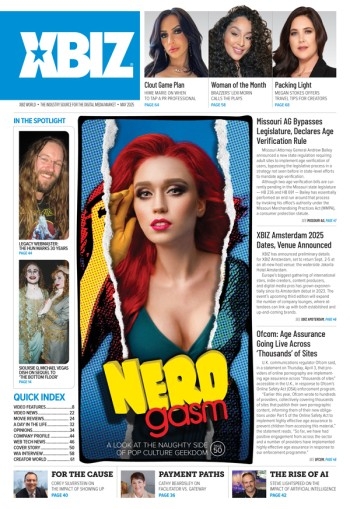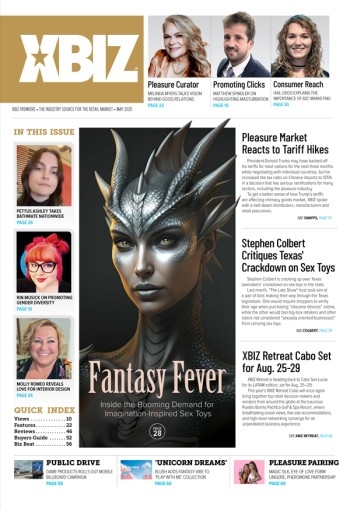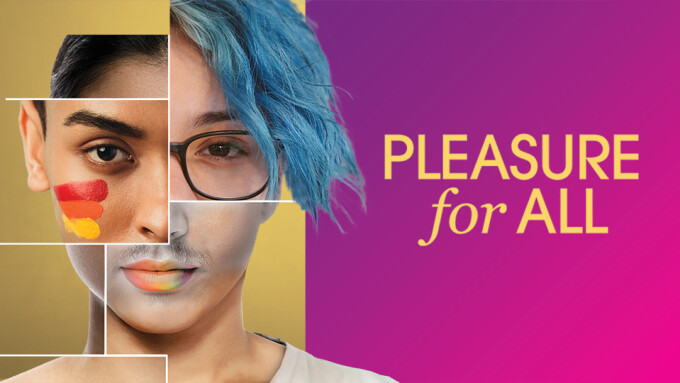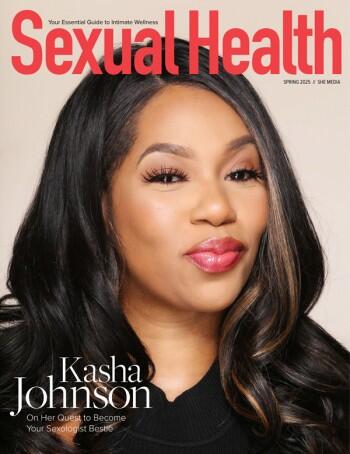From gender-affirming products and realistic toys representing a variety of skin tones to sex accessories made to facilitate pleasure for those with physical disabilities or pain, manufacturers of pleasure products are increasingly incorporating inclusivity into their designs.
The global research consulting firm McKinsey released a report in 2022 showing that diversity and inclusion are deeply important to consumers. Titled “The Rise of the Inclusive Consumer,” the report stated that “the American consumer is undeniably becoming more inclusive” and shared research which found that for two out of three Americans, social values help to shape shopping choices. For instance, McKinsey found that “45% — likely representing well over a hundred million shoppers — believe retailers should actively support Black-owned businesses and brands.”
Discussions of inclusiveness and diversity are often met with the argument that, if there were value in inclusivity, the free market would push for it. Yet in its 2020 report,“Diversity wins: How inclusion matters,” McKinsey published data indicating that the more diverse a company is, the more likely it is to succeed. On the consumer side, Nielsen has found that LGBTQ+ audiences are becoming increasingly influential. Every piece of available data consistently shows that increases in diversity lead to increases in cash flow.
While this is mainly based on data collected on mainstream businesses, the same consumer behavior is reshaping the pleasure products industry. While some consumers have been buying more products, much of the recent success in this sector stems from the pleasure product consumer base becoming far more diversified — and as more people from different backgrounds purchase pleasure products, the industry is being pushed to become more inclusive as a result.
Many industries are stubborn and resistant to change, but the pleasure products industry is not one of them. As Ian Kulp, head of sales in the U.S. and Canada for Je Joue, explained, “The pleasure industry naturally appeals to a more open-minded and free audience and so it’s essential that we are accepting of all types of persons, desires and comfort levels.” While this sector might have some individual leaders who are reluctant to change, as a rule the inherent nature of its customers forces the people in charge to be more open.
Further discussing the topic of inclusion, Kulp noted that “a real shift has developed in the way that products are built, with all bodies and partnerships in mind. This shift is a reflection of how the world is becoming more understanding and open to sexualities.” With more people speaking up about their life experiences, Kulp added, the industry must “keep progressing and learning” in order to remain profitable.
It is important to understand that these are not just consumers in the abstract, but members of distinct communities showing the industry how it has to expand to appeal to these markets.
According to Claire Blakeborough, marketing and communications manager of Cyrex Ltd., people want to buy from companies that share their values. For instance, Blakeborough said, Cyrex brand ElectraStim “has always had a huge LGBTQIA customer base who are passionate and informed about the electro niche,” so it is important that the company is seen “as an ally who will stand up for the community.”
This year, WOW Tech Group launched its Pride Fund to partner and support adult retailers’ grassroots LGBTQ inclusivity efforts. The initiative provided retailers across Canada and the U.S. with financial backing for projects celebrating and supporting the LGBTQ+ community, such as events and fundraisers. Fourteen recipients were announced in June, with retailers such as The Pretty Pussycat in Bend, Oregon hosting an adult prom for their LGBTQ+ community to create the opportunity for people to attend prom as their authentic selves, and Come As You Are in Toronto, Ontario using its funding to expand its low-cost gender-affirming clothing program to include gear for trans-feminine people and non-binary people.
“This year, the objective of the WOW Tech Pride Fund was to increase LGBTQ+ inclusivity and visibility at a local level in North America,” WOW Tech Marketing Director Stephanie Keating said. “Retailers actively advocate for their Pride communities, and we wanted to support their efforts. During the application process, we learned about retailers who felt their community had little LGBTQ+ presence and wanted to make a change. We also heard from those who wanted to raise awareness, create an inclusive space, or provide education through events. In collaboration with retailers, this initiative made a direct impact.”
For people like Adam Lea, the Australasian marketing manager for Wild Secrets, it makes sense that the industry would have to become more inclusive as the consumer base expands.
“As more consumers enter into the pleasure products category each year, the industry is no longer a niche purchase to be made in secret,” Lea said. “Inclusivity is driven by fulfilling a need to provide products that cater to a much larger audience, and to each and every sexuality and gender identity.” As the consumer base for pleasure products expands and evolves, Lea observed, so must the sector’s product offerings.
Lea is far from alone in holding this opinion. For Natasha Marie Narkiewicz, head of communications and sexual wellness expert at MysteryVibe, this shift was inevitable.
“When we think of pleasure products, people often associate them with luxury items — things we don’t need,” Narkiewicz reflected. Yet the growth of the pleasure products sector has shifted those associations away from “luxury” and towards being part of a generally healthy lifestyle. Meanwhile, as cultural attitudes towards sex have shifted, “the taboo of pleasure has lessened, and sexual wellness and pleasure have garnered interest and popularity among mainstream society.”
Narkiewicz further observed, “We see the exclusivity of pleasure reflected in traditional sexual wellness product designs with most devices being for healthy, young and able-bodied adults,” and noted that the increased popularity of pleasure products has opened the way for hearing grievances “from whole demographics of people who have been left out of the pleasure paradigm.” Among these are people with disabilities or chronic illnesses, older populations, the LGBTQ+ community and people who have undergone gender-affirming surgeries.
Rising awareness that pleasure products creators have historically ignored too many people has made market demand for more inclusive pleasure products “the highest it’s ever been,” Narkiewicz said. For many companies, that makes right now the perfect time to rethink who their customer base is and proactively redesign products to reflect the wants and needs of these diverse communities.
Consumers want to be included and are making themselves noticed and heard. As Lovense’s community and content manager, Alicia, pointed out, consumers are incredibly vocal about what products they want to see offered.
“Social media has changed everything, allowing normal people to express their wants and needs,” she observed. While traditional mainstream media fed audiences content that only reflected a small segment of the population, “millennials and Gen Z have taken ownership of their identities, breaking apart from tradition and what is expected from them, including their relationship with sex and their own bodies.”
“That shift in consumer mentality,” says Alicia, “has pushed global brands to follow their lead and provide more diverse representation. If your company is not ticking all the boxes, then people will go elsewhere.”
Listening to customer feedback has inspired companies to take inclusivity more seriously as an important consideration in product development.
“Can you get a better source of inspiration than your end users? We all have different needs, and our job is to put it all together and create toys that adapt to everybody's needs,” Alicia said. “Testers will give final suggestions and that is when the magic happens! A new toy is born.”
While some manufacturers are rethinking their product development and packaging to reflect today’s diverse consumer base, many newer pleasure product brands and retailers were launched specifically with the vision of uplifting marginalized communities.
Bawdy Bookworms founder Thien-Kim Lam said that her Vietnamese heritage inspired her company’s objective of highlighting diversity in the romance book industry.
“We seek out diverse romance novels for our subscription boxes, and we want to pair them with pleasure products that represent those values in their design, packaging and marketing copy,” she said.
A kind of “subscription box meets virtual book club,” Bawdy Bookworms showcases books from a range of authors and declares its commitment to “lifting diverse voices in romance” on its website. A page dedicated to this mission addresses how the company defines diversity and features an FAQ section that further explains its guidelines for the books it carries.
“Bawdy Bookworms was created to give our audience of adventurous romance readers more inclusive books and toys,” Lam said. “We provide a wide range of books with BIPOC, LGBTQIA+, neurodiverse and other characters from traditionally marginalized communities.”
According to Lam, Bawdy Bookworms also includes a different type of pleasure product with each subscription box so its customers can build their own diverse collection.
Similarly, Narkiewicz said that MysteryVibe’s core belief that “pleasure is personal, and a fundamental right to all people” is reflected in the design of all its products.
“Everyone deserves to express themselves and experience pleasure as they see fit,” Narkiewicz said. “Each of the products is designed to be as accessible and inclusive as possible for a wide range of ages and circumstances. The design process is user-driven. We amass and incorporate feedback from consumers and health care professionals to ensure our products work with a diverse range of anatomies and circumstances.”
In addition, Narkiewicz said, MysteryVibe products function as assistive technology that mitigates sexual dysfunctions that are often overlooked, such as erectile dysfunction, arousal disorder and pelvic pain.
“Pain is the largest obstacle in the way of pleasure, and sexual health is nuanced at any age,” Narkiewicz said. “MysteryVibe has found that the one-size-fits-all model alienates many people from the experience of pleasure, which is why we pioneered body-adaptability with the first bendable, ultraflexible vibrators that fit different body shapes and sizes, as well as one of the first gender-agnostic vibrators, Crescendo 2. Our products are registered FDA II medical devices, doctor-endorsed and clinically proven to help with sexual dysfunction.”
Whether they’re made for people with vulvas or penises, pleasure products are being refined with more versatile shapes to serve different body types. Alicia pointed out that Lovense items like Ferri, Dolce and Lush 3 were designed to be hands-free and make pleasure more accessible for users with dexterity issues.
“Our developers and designers work tirelessly to generate the most pleasurable, intuitive experience with unique, versatile toys that adapt to every body type,” she said. “All Lovense toys are also fully compatible with Lovense Remote, which has a variety of features such as local remote control and long-distance control, music-based vibrations, creating and sharing patterns, syncing two toys together, sound-activated vibrations and so on. We offer APIs that can be integrated with myriad third-party apps and platforms. For example, 3DXchat is an adult game with a metaverse interface and is compatible with Lovense toys. You can choose an avatar of any gender and have virtual sex with another player. There are so many possibilities in this field.”
Above all, Alicia added, Lovense is “a company whose hardware and software focus on sex technology and wellness. Individuals with disabilities, non-normative bodies, etc. can use technology to make their sexual and intimate encounters easier.”
The modernization of pleasure products and of consumers’ acceptance of sextech products has spawned the development of innovative functions made especially for the stimulation of vulvas and penises. Today’s pleasure products are made to target specific erogenous zones based on anatomy with a variety of movements, ranging from traditional vibrations — which have evolved from primarily being in toys for vulvas to including today’s array of vibrating strokers — to thrusting, rotating, inflating and more.
Electrostimulation is another function that is inherently gender-neutral.
“Of course, there are toys designed for specific genitals or pleasures, but at its core, electro-sex is a diverse kind of play,” said Claire Blakeborough of Cyrex. “Whereas a toy like a rabbit vibrator only really has a single way to play, electro can be used in a huge range of scenarios, from relaxing and sensual to hardcore fetish.”
As part of ElectraStim’s efforts to be inclusive, Blakeborough said, the company is being more conscious about the language used on packaging and in marketing materials.
“For example, whereas we had a 'For Men' category on our website for a long time, in recent years we've changed this wording so it's more inclusive yet descriptive,” she said. “Not all men have — or indeed, want to play with — a penis, so now you'll find these accessories under Cock Rings and Penis Toys. This is an ongoing balancing act between what's best for our audience and what works for SEO, so we're constantly monitoring and updating.”
Mapalé also aims to express inclusivity through its marketing messages.
“At Mapalé we seek to support and celebrate differences, as well as to promote positive changes in our community,” said Andrea Rodriguez, a Mapalé business development executive. “We take great pride in catering to a variety of consumers of different ethnicities, backgrounds, orientations and sizes. We show this through our models who are the stars of Mapalé. We are proud to have trans women, people of color, plus-size queens and women of all ages within our family.”
Intentionally Inclusive
While realistic pleasure products are being refined with a greater variety of tones available, to which diverse customers can better relate, nonrealistic, gender-neutral designs also can be relatable for consumers who don’t want to attach their toy to a particular gender or sexuality.
“Products that are nonrealistic in design or appearance while still providing pleasure to the user play a large part in the growth of the industry,” Wild Secrets’ Adam Lea said. “Nonrealistic products provide a solution for consumers who want to explore their own sexuality but may find a realistic product confronting. Realistic products may also contribute to feelings of body dysmorphia with trans users.”
ElectraStim’s Claire Blakeborough noted that the e-stim products manufacturer also favors non-anatomical designs for its accessories, such as dildos that are phallic but not realistic and the Jack Socket male masturbator, which has a textured inside but a nondescript circular orifice that isn't designed to mimic any body part.
“Not every product we create is suitable or appealing to every type of person but we're confident that there's something in our catalog for everyone who is intrigued by electro,” Blakeborough said. “By putting inclusivity at the front of our minds during the design process, I really believe that we're creating better products with much wider appeal.”
Blakeborough also noted that in addition to intentionally being gender-neutral, ElectraStim also developed its tech to facilitate pleasure for all users.
“The Gesture and Proximity modes within the AXIS stimulator were designed not only as fun and unique ways to play, but also with accessibility in mind,” Blakeborough said. “Users with limited dexterity are able to control the modes and intensities of stimulation in this mode simply by waving in front of the sensor on the front of the unit. The sensor will pick up any solid object, so it doesn't necessarily have to be a hand either.”
Le Wand Internal Vibes were also crafted with an emphasis on flexibility to make pleasure more accessible.
“While the shapes can be considered reminiscent of similar products, it was important to create these items with innovation and, in this case, it was quite clear that more rigid versions of these types of products limited who can use them,” COTR’s Kimberly Scott Faubel said. “We also received plenty of feedback about our bestselling b-Vibe Snug Plugs, and created a larger flared base to accommodate a more diverse range of body types. We’re always listening not only to the people who sell the items, but the folks who are actually using them.”
Lovense’s Alicia highlighted Cute Little Fuckers as a brand that best represents inclusivity, adding that overall, more brands are focusing on largely overlooked groups such as queer people, people with disabilities and people who suffer from body dysmorphia or chronic illness.
“Cute Little Fuckers was created with the inclusivity aspect as a core value, to cater to the most diverse group of customers, and especially keeping in mind the needs of nonbinary and disabled people,” she said. “The whole concept and execution of this project, as well as the support it got through Kickstarter, shows that it is the right direction for brands to follow.”
Although the pleasure products industry has begun valuing representation and inclusivity more within the past couple of years, COTR’s Faubel pointed out that the work is never complete.
“It’s a process and an ongoing practice of learning and, perhaps more importantly, unlearning what we have been conditioned to in this country,” she said. “We began our work with DEI training when a lot of other folks did. For a year, we regularly met with an expert in this field and the tools we were given have provided ongoing research, learning, unlearning and awareness. We also will be continuing this work as a team and with any new folks that are onboarded. The importance of a diverse staff? Frankly, we feel our team should reflect the world we live in. I’m capable of considering another person’s perspective, but I haven’t lived it. Personally, as a queer, gender-fluid white person, I am not a monolith, and I can only share from my own life. It’s crucial to have folks who have lived their lives feel safe and comfortable enough to share their perspective and know that their feedback and POV is important, valued and crucial to our growth.”
SOS Distribution was the first supplement company to brand a unisex enhancement product, Surge for All.
“Surge for All is a potent two-ounce pleasure enhancement shot that can be enjoyed by all/any couples regardless of gender,” SOS Distribution CEO Hamed Bossett-Allen said. “We noticed there’s no enhancement products for people who do not identify as men or women. As was common practice, products are labeled ‘male enhancement’ and ‘female enhancement,’ cutting out a large and rapidly growing sector. You won’t find any pronouns on our descriptors for most of our brands, and this was a conscious decision SOS Distribution made well over five years ago. Penis owners and vulva owners do not always relate to ‘male’ and ‘female,’ and respectfully it doesn’t hurt anyone to drop ‘he,’ ‘she,’ ‘her,’ or ‘his’ pronouns. It adds many more buyers you may have overlooked or innocently not considered.”
Team Inclusive
When a company consists of a diverse team, it’s more likely that its brands and products will reflect that, serving and feeling welcoming to all consumers and their wide-ranging identities. According to Bossett-Allen, that is why SOS solicits feedback from its B2B clientele “who may have a different viewpoint so that we may see the world through an opposing lens.”
“Buyers, store managers and sales associates nationwide are a very diverse group of wonderful people who can really help with their input,” he said. “If you’re looking for inclusivity ideas, it’s a great place to start.”
To avoid alienating segments of consumers, Bossett-Allen suggests conducting routine team think tanks and hiring and maintaining a diverse workforce, from brand ambassadors, designers, HR specialists and programmers to VPs and CEOs.
“If diversity is only found in the warehouse, you’re failing as a company,” he said.
Thien-Kim Lam from Bawdy Bookworms employs several different approaches to encourage more diverse applicants for her team.
“Bawdy Bookworms doesn’t require a resume if the applicant can share a detailed work history and experience,” she said. “We also work with our community to share the job listing in nontraditional spaces, such as online groups and word of mouth. While the job listing notes our commitment to diversity and inclusion, we aim to demonstrate that commitment in our subscription boxes and on our social media and website.”
Ian Kulp of Je Joue said that the company practices and executes diversity with the hiring of its global team of talent and brand ambassadors.
“It’s disingenuous to speak on someone’s behalf, and so it’s essential that there is a diverse range of voices and input into the business to ensure we are being inclusive and equitable,” he said.
Adam Lea said that Wild Secrets aims to maintain a staff that represents the customers the company serves and is grateful to be situated in inner-city Melbourne where it can attract “a certain liberal sort of employee.”
“We haven’t needed to mandate any particular mix, but they are from a broad range of ethnicities, cultures and communities,” Lea said. “Diversity is important because it allows us to understand our customers more clearly. We believe in a society free from shame about all things to do with sex, within the law.”
Narkiewicz said that the company prides itself on having staff members from diverse backgrounds, ages, ideologies and geographies.
“Every employee’s perspective is respected and championed because we believe true innovation comes from challenging the status quo and considering all possible angles,” she said.
International sextech brand Lovense also proudly maintains a multinational staff.
“We have representation of different genders, body types and races to make sure we have the most complete spectrum of views on diversity and inclusivity,” Alicia said. “I would like to think we educate each other along the way about the different aspects of life — and of course, sexuality — in a fun and respectful way.”
Recognizing that ElectraStim’s marketing imagery was somewhat lacking in inclusivity, Claire Blakeborough said, the company has made more of a concentrated effort to feature people of all backgrounds.
“It was never a deliberate choice to feature largely white, male models, but by recognizing that it was very limiting and putting in some effort, we're now able to use a much broader range of gorgeous model shots that are much more representative of our real audience,” she said. “Social media is probably the main place where we represent our inclusivity as a brand on a continuous basis. In recent years, we've also severed ties with an advertiser that had connections to a proudly anti-trans organization, and we also publicly addressed a number of bigoted complaints when we started using Daniel Quasar's 2019 redesign of the Pride flag on some advertising, with new colors added to represent the black and trans communities. The positive response we get whenever we celebrate diversity, in terms of engagement and retweets, just proves to me that people appreciate the sentiment.”
Marketing Matters
With consumers making it clear that they want brands to embrace inclusiveness and diversity, companies are slowly beginning to redesign products and packaging in response.
Thien-Kim Lam of Bawdy Bookworms has noticed this change taking place. Lam shared, “I’m glad to see that packaging and marketing for pleasure products are changing to be more inclusive. We know that a toy can be used in several different ways, but gendered or heteronormative descriptions can turn off customers who don’t fit those assumed demographics.”
The company applies the same rule to images on packaging.
“Marketing is evolving but there’s still a lot of work to be done,” Lam said. “For example, products geared towards vulva owners still have images of thin, white women on them.”
For Lam, the solutions to this problem are simple. “Either remove the photos or include several photos representing women and nonbinary folx of different sizes and ethnicities,” Lam suggested. “I want to see more brands rename flesh-toned toys to something other than food such as chocolate for dark brown skin. That’s very problematic.”
Though many companies are now utilizing inclusive elements in their marketing, few have thrown themselves into this effort as much as Wild Secrets. According to Lea, the company’s recent television commercials were inclusivity-themed and included “a multicultural and differently-abled cast.”
One of the people featured is Akii Ngo, a model/actor and disability activist. Reflecting on their role in the campaign, Ngo shared the following: “I am a disabled, autistic, young, mobility aid-using, nonbinary trans, LGBTIQA+/queer model of color from a refugee background, and being part of this TVC campaign was not only incredibly fun but also extremely rewarding.
“This is because I am deeply passionate about intersectional, non-tokenistic representation, especially positive disability representation within all spaces, including the fact that everyone deserves rewarding, pleasurable sex lives regardless of our abilities," Ngo continued.
For Ngo and people like them, inclusive pleasure products offer a chance to experience sex that is free from stigma, and to break down beliefs that disabled people should live divorced from sexual desires.
Another person featured by Wild Secrets is Clementine Ford. Mirroring Ngo’s points, Ford shared that she was “thrilled to be part of a campaign that helps to normalize the use of toys and play to explore sexual pleasure. There’s nothing shameful about enjoying a wide variety of sexual experiences, and sex toys are a unique and important part of this.”
Overall, Wild Secrets found that it could successfully build a community around its brand by directly including people who have been left out of previous marketing campaigns. Meanwhile, Lovense has created products – such as Hyphy and Gush – designed to adapt to more diverse markets. However, Lovense’s Alicia noted, no one should be thanked for simply doing the smart or right thing.
“You can look around and see how being inclusive is becoming the norm,” she explained. “It is almost expected as a bare minimum from companies.”
Diversity Is the Future
Big topics like inclusivity will always elicit a variety of opinions. However, the leaders who offered insights for this piece shared one particular sentiment: inclusivity in the pleasure products industry is here to stay.
“It would be near impossible for the adult industry to evolve into inclusivity without a dramatic shift in marketing,” explained Hamed Bossett-Allen of SOS. “Luckily that dramatic shift is happening as we speak. More and more, we’re seeing people of all shapes and sizes, people of color, multiracial couples, LGBTQ community members and LGBTQ couples reflected in companies' marketing strategies and core values.”
Even though the industry has courted members of the LGBTQ+ community, this shift represents a new dynamic. Instead of being one-way, the relationship between producers and consumers has evolved into a conversation. This means that companies are not only expected to design and refine items based on consumer feedback, but they are also expected to engage with the communities they sell to.
As Bossett-Allen concluded, “It’s up to us all to ensure we are listening and creating a series of brands with more conscious imagery and verbiage for more inclusive demographics.”
Beyond marketing and brand messaging, pleasure product companies are embracing diversity in all aspects of business, from product development to staffing. By making sure inclusivity is more than just a buzzword, the industry is becoming more effective at providing pleasure for all.







